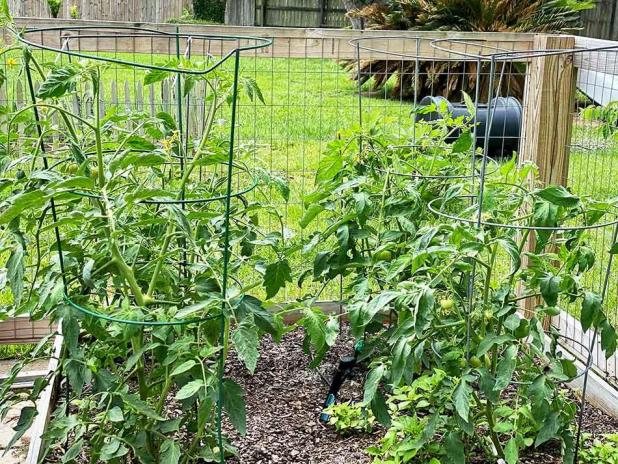
Tomatoes should be caged or staked to help prevent disease and to provide support for large, heavy fruit.
—LSU AgCenter/Heather Kirk-Ballard
Get It Growing: Summer flower and garden tips
There are many things to be done in the lawn and in the garden as we transition from the spring into the summer. One thing to consider if you haven’t already done so is replacing your cool-season bedding plants with warm-season bedding plants.
Traditional cool-season annual bedding plants such as alyssum, baby’s breath, delphinium, dianthus, dusty miller, foxglove, ornamental cabbage and kale, pansies, snapdragons, stock and violas will begin to fizzle out from the warming nights and hot days. As these begin to fade, it’s time to think about what you will do with that area.
A great place to start is the Louisiana Super Plants list on the LSU AgCenter website. This summer’s selection is Suncredible Yellow sunflower (Helianthus hybrid). It’s a sweet little sunflower that provides a pop of color all summer and throughout the fall. Suncredible Yellow is a continuous bloomer that holds its flowers for extended periods and makes a great cut flower with up to 4-inch blooms.
The good news is these sunflowers do not need to be deadheaded to encourage more blooms. They can be trimmed to keep them tidy and shaped to your liking. These gorgeous flowers attract bees and butterflies, providing nectar to pollinators. Deer do not seem to care for them. Sunflowers are native to North America, so this is a great chance to cultivate a native plant.
Plants grow in an upright habit to 36 inches and spread to 32 inches. They can be used individually or grouped together en masse to make a hedged area. They prefer full sun for the best bloom production and adapt to all types of soils with average water use. Once established, they are drought and heat tolerant. Water in extended periods of drought. These will perform well in both the landscape and in container plantings.
Suncredible sunflowers are an easy-care, low-maintenance addition to your summer landscapes. To encourage vigorous growth and plentiful blooms, you can use a controlled-release fertilizer when you plant. Apply another round in mid- to late summer.
Some other great Louisiana Super Plant recommendations for the summer into the fall are the Serena series and Serenita Raspberry angelonia, Star and Butterfly series pentas, Evolution series salvias, Flame Thrower and Henna coleus, Lemon sedum, Intenz Classic celosia, Mesa series gaillardia, Senorita Rosalita cleome, Bandana lantana and so many more.
Consult the full list for ideas for your specific area. There are options for shaded areas, ground covers, pollinator plants and whatever else you may be looking for.
In addition to updating annual color in your landscape, there is plenty to do elsewhere.
In the vegetable garden, it’s time to stake tomato plants. You may continue to plant warm-season vegetables such as beans, tomatoes, eggplant, okra and peppers.
Try something different such as amaranth, cucuzza, cushaw, Malabar spinach, edamame (soy beans), peanuts, luffa gourds, mirliton and yard-long beans. You can plant heat-tolerant herbs such as basil, mint, oregano, lemon balm, garlic, chives, rosemary, bergamot, hyssop, lemon grass and Mexican tarragon.
In the lawn, keep up the weed control. Fungal diseases are prevalent this time of year. Water when rain is scare, and continue to treat for fungal issues. If you fertilized in March, you may go ahead and fertilize again late this month.
Sod can be laid from now through September. This also is a great time to aerify and dethatch your lawns.
Aeration helps penetrate and reduce thatch buildup or prep it for removal. There are three main ways to aerify your lawn. You can use spikes that poke holes in the soil; a slicer that uses blades to cut through the soil; or core or plug removal, which removes a small core of soil. Any of these approaches will help improve drainage and air movement around the roots.
Thatch is the layer of dead grass found in between the green vegetative grass and the root system and soil below it. If this thatch layer becomes greater than ½ inch, it should be removed to maintain lawn health.
In landscape beds, be sure to water and mulch. Continue planting bedding plants and shifting from cool-season annuals to warm-season annuals. Also try perennials and plants that attract pollinators such as bees, butterflies and hummingbirds. Options include angel’s trumpet, aster, bee balm, butterfly bush, butterfly weed, cupheas, firecracker bush, lantana, sage, salvia, scabiosa, shasta daisy, sedums, verbenas, yarrow and zinnias.
This also is a good time to prune spring-blooming shrubs. Prune no later than July to encourage new growth. Be careful to not prune summer-blooming shrubs such as althea (rose of Sharon), gardenias and hydrangeas.
